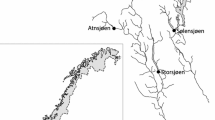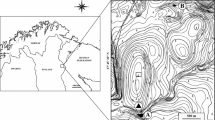Abstract
Although landlocked Arctic charr, Salvelinus alpinus, occur in a large number of High Arctic lakes and often as the only fish species, knowledge of densities and resource use is limited. An allopatric landlocked population of Arctic charr in the 1.47 ha Lake Nordre Borgdam on Svalbard (78°3′N, 13°5′E) was studied during the period 1998–2004. Population abundance was estimated by mark–recapture in July–August 2001. The population was dominated by small individuals with lengths below 16 cm. In 2001, the total number of charr in the length-class 6.0–15.9 cm corresponded to 1,920 individuals/ha or 20.7 kg ha−1. They were mostly feeding on chironomid and trichopteran larvae. The few larger charr seem to feed mainly on smaller conspecifics, and these cannibals probably control the population structure and the abundance of smaller fish. Due to low total number of prey fish in the lake, few individuals are likely to become piscivores.





Similar content being viewed by others
References
Berg OK, Finstad AG, Olsen PH, Arnekleiv JV, Nilssen K (2010) Dwarfs and cannibals in the Arctic: production of Arctic char (Salvelinus alpinus (L.)) at two trophic levels. Hydrobiologia 652:337–347
Borgstrøm R (1992) Relationship between annual recruitment and density in a lacustrine population of allopatric brown trout (Salmo trutta). Can J Fish Aquat Sci 49:1107–1113
Borgstrøm R, Museth J (2005) Accumulated snow and summer temperature - critical factors for recruitment to high mountain populations of brown trout (Salmo trutta L.). Ecol Freshw Fish 14:375–384
Borgstrøm R, Ebne I, Svenning M-A (2010) High lacustrine gillnet catchability of anadromous Arctic charr. Hydrobiologia 650:203–212
Bøyum A, Kjensmo J (1978) Physiography of lake Linnévatn, Western Spitsbergen. Verh Internat Verein Limnol 20:609–614
Bylund G (1973) Observations on the taxonomic status and the biology of Diphyllobothrium ditremum (Creplin, 1825) (=D. osmeri (von Linstow, 1878)). Acta Acad Aboensis 33(19):1–18
Byström P (2006) Recruitment pulses induce cannibalistic giants in Arctic char. J Anim Ecol 75:434–444
Christensen JM (1964) Burning of otoliths, a technique for age determination of soles and other fish. J Cons Perm Int Explor Mer 26:73–81
Claessen D, Van Oss C, de Roos AM, Persson L (2002) The impact of size-dependent predation on population dynamics and individual life history. Ecology 83:1660–1675
Dahl K (1917) Studier og forsøk over ørret og ørretvann. Centraltrykkeriet, Kristiania. (In Norwegian)
Dick TA, Gallagher CP, Yang A (2009) Summer habitat use of Arctic char (Salvelinus alpinus) in a small Arctic lake, monitored by acoustic telemetry. Ecol Freshw Fish 18:117–125
Finstad AG, Jansen PA, Langeland A (2001) Production and predation rates in a cannibalistic Arctic char (Salvelinus alpinus L.) population. Ecol Freshw Fish 10:220–226
Godiksen J, Svenning M-A, Sinnatamby RN, Dempson JB, Borgstrøm R, Power M (2011) Stable isotope-based determinations of the average temperatures experienced by young-of-the-year Svalbard Arctic charr (Salvelinus alpinus (L.)). Polar Biol 34:591–596
Griffiths D (1994) The size structure of lacustrine Arctic charr (Pisces: Salmonidae) populations. Biol J Linn Soc 51:337–357
Guiguer KRRA, Reist JD, Power M, Babaluk JA (2002) Using stable isotopes to confirm the trophic ecology of Arctic charr morphotypes from Lake Hazen, Nunavut, Canada. J Fish Biol 60:348–362
Gulseth OA, Nilssen KJ (2000) The brief period of spring migration, short marine residence, and high return rate of a northern Svalbard population of Arctic char. Trans Am Fish Soc 129:782–796
Halvorsen O (1970) Studies of the Helminth Fauna of Norway XV: On the taxonomy and biology of plerocercoids of Diphyllobothrium Cobbold, 1858 (Cestoda, Pseudophyllidea) from north-western Europe. Norw J Zool 18:152–174
Halvorsen O, Andersen K (1984) The ecological interaction between arctic charr, Salvelinus alpinus (L.), and the plerocercoid stage of Diphyllobothrium ditremum. J Fish Biol 25:305–316
Hammar J (1985) The geographical distribution of the Arctic charr (Salvelinus alpinus (L.)) species complex in Svalbard. In: ISACF Information Series No 3. Proceedings of the third ISACF workshop on Arctic charr, 1984. Inst Freshw Res Drottningholm, pp 29–37
Hammar J (1989) Freshwater ecosystems of Polar regions: vulnerable resources. Ambio 18:6–22
Hammar J (2000) Cannibals and parasites: conflicting regulators of bimodality in high latitude Arctic char, Salvelinus alpinus. Oikos 88:33–47
Johnson L (1983) Homeostatic characteristics of single species fish stocks in Arctic lakes. Can J Fish Aquat Sci 40:987–1024
Johnson L (1994) Long-term experiments on the stability of two fish populations in previously unexploited Arctic lakes. Can J Fish Aquat Sci 51:209–225
Kerekes JJ (1990) Possible correlation of summer common loon (Gavia immer) population with the trophic state of a water body. Verh Internat Verein Limnol 24:349–353
Klemetsen A, Grotnes PE, Holthe H, Kristoffersen K (1985) Bear Island charr. Rep Inst Freshw Res Drottningholm 62:98–119
Kristoffersen K, Halvorsen M, Jørgensen L (1994) Influence of parr growth, lake morphology, and freshwater parasites on the degree of anadromy in different populations of Arctic char (Salvelinus alpinus) in Northern Norway. Can J Fish Aquat Sci 51:1229–1246
Larsson S, Berglund I (2005) The effect of temperature on the energetic growth efficiency of Arctic charr (Salvelinus alpinus L.) from four Swedish populations. J Therm Biol 30:29–36
Lien L (1978) The energy budget of the brown trout of Øvre Heimdalsvatn. Holarc Ecol 1:279–300
MacCallum W (1972) Arctic char study. In: Rigler FH (ed) Char Lake project PF-2 annual report 1970-1971. Ottawa, Canadian Committee International Biological Program, pp 67–83
O’Connell MF, Dempson JB (2002) The biology of Arctic charr, Salvelinus alpinus, of Gander Lake, a large, deep, oligotrophic lake in Newfoundland, Canada. Environ Biol Fish 64:115–126
Parker HH, Johnson L (1991) Population structure, ecological segregation and reproduction in non-anadromous Arctic charr, Salvelinus alpinus (L.) in four unexploited lakes in the Canadian high Arctic. J Fish Biol 38:123–147
Power G (1978) Fish population structure in arctic lakes. J Fish Res Board Can 35:53–59
Ricker WE (1975) Computation and interpretation of biological statistics of fish populations. Bull Fish Res Board Can 191:1–328
Rigler FH (1975) The Char Lake project, an introduction to limnology in the Canadian Arctic. In: Cameron TWM, Billingsley LW (eds) Energy flow–it’s biological dimensions, A summary of the IBP in Canada 1964–1974. Royal Society of Canada, Ottawa, pp 171–198
Sandlund OT, Forseth T (1995) Bare få ørreter kan bli fiskeetere. In: Borgstrøm R, Jonsson B, L’Abee-Lund JH (eds) Ferskvannsfisk Økologi, kultivering og utnytting. Norwegian Research Council, Oslo, pp 78–85 (In Norwegian)
Saunders LH, Power G (1969) The Arctic char, Salvelinus alpinus (Linnaeus), of Matamek Lake, Quebec. Nat Can 96:919–934
Sierszen ME, McDonald ME, Jensen DA (2003) Benthos as the basis for arctic lake food webs. Aquat Ecol 37:437–445
Svärdson G (1976) Interspecific population dominance in fish communities of Scandinavian lakes. Rep Inst Freshw Res Drottningholm 55:144–171
Svenning M-A, Borgstrøm R (1995) Population structure in landlocked Arctic charr. Sustained by cannibalism? Nordic J Freshw Res 71:424–431
Svenning M-A, Borgstrøm R (2005) Cannibalism in Arctic charr: do all individuals have the same propensity to be cannibals? J Fish Biol 66:957–965
Svenning M-A, Gullestad N (2002) Adaptations to stochastic environmental variations: the effect of seasonal temperatures on the migratory window of Svalbard Arctic charr. Environ Biol Fish 22:165–174
Svenning M-A, Klemetsen A, Olsen T (2007) Habitat and food choice of Arctic charr in Linnévatn on Spitsbergen, Svalbard: the first year-round investigation in a High Arctic lake. Ecol Freshw Fish 16:70–77
Acknowledgments
We thank Carina R. Isdahl and Lars Knutsen for assistance in the field work, the staff at Kapp Linné for practical assistance, the Governor of Svalbard for transport between Longyearbyen and the field station, and Longyearbyen Hunting and Fishing Association for allowance to use their cabin at Russekeila. We also acknowledge Jenny Stien for improving the English. We highly appreciate the corrections and suggestions given by three anonymous referees, as well as all suggestions given by the editor, Dieter Piepenburg, for improving the manuscript.
Author information
Authors and Affiliations
Corresponding author
Rights and permissions
About this article
Cite this article
Borgstrøm, R., Isdahl, T. & Svenning, MA. Population structure, biomass, and diet of landlocked Arctic charr (Salvelinus alpinus) in a small, shallow High Arctic lake. Polar Biol 38, 309–317 (2015). https://doi.org/10.1007/s00300-014-1587-6
Received:
Revised:
Accepted:
Published:
Issue Date:
DOI: https://doi.org/10.1007/s00300-014-1587-6




